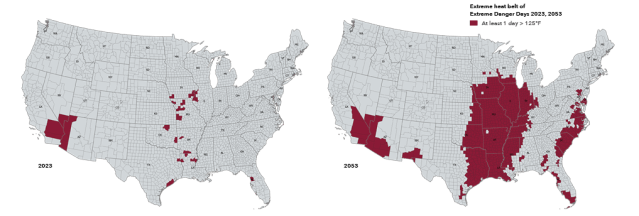Watch out for the ‘extreme heat belt’ developing across the central US
An “extreme heat belt” that stretches across the center of the US is expected to emerge over the next 30 years, subjecting millions more Americans to dangerously hot days. That’s according to new research published today by the nonprofit research group First Street Foundation.
The belt is expected to extend from Texas and Louisiana all the way up to Wisconsin. Along the belt, extremely hot days could feel brutal, reaching temperatures that feel hotter than 125 degrees Fahrenheit.
About 107.6 million Americans across 1,023 counties will experience that level of extreme heat at least one day a year by 2053. That’s compared to just 8.1 million residents in 50 counties who can expect to suffer through such high temperatures in 2023, according to First Street’s analysis.
“We need to be prepared for the inevitable, that a quarter of the country will soon fall inside the Extreme Heat Belt with temperatures exceeding 125°F and the results will be dire,” Matthew Eby, founder and CEO of First Street Foundation, said in a press release.
That figure, 125 degrees, is a measure of heat and humidity called a heat index. It’s often referred to as what the temperature “feels like.” Anything 125 degrees Fahrenheit or higher falls into the National Weather Service’s highest heat index category — signaling “extreme danger” when heat stroke is “highly likely.”
 Image: First Street Foundation
Image: First Street Foundation Even if you don’t live within that extreme heat belt, you can expect temperatures to rise higher than what your community has experienced in the past, the research warns. “Virtually the entire country is subject to increasing perils associated with heat exposure,” the report says. That’s no surprise, of course — climate change is pushing the weather to extremes across the world.
What’s cool about this new research is that you can zoom in to see the changes that your home might have to adapt to in the future. Just plug your address into Fist Street’s “Risk Factor” search tool online. That’ll pull up information on how many more hot days the location is expected to experience in 30 years. I searched for my childhood home in Southern California and found that it might see 11 days a year with a heat index above 99 degrees Fahrenheit compared to just four days this year. (You’ll also see wildfire and flood risk when you search for an address on the Risk Factor tool.)
To figure out how much each location will bake in the future, the researchers first looked at the heat index for the seven hottest days it experienced this year. Then, using federal government datasets and other publicly available resources, it built a model to estimate how often the location would experience days that hot three decades from now.
Miami-Dade County in Florida is on track to experience the biggest increase in the frequency of its hottest days. Currently, the heat index here reaches 103 degrees Fahrenheit during the seven hottest days of the year. By 2053, more than 30 days a year would feel that hot, according to First Street’s research.
An “extreme heat belt” that stretches across the center of the US is expected to emerge over the next 30 years, subjecting millions more Americans to dangerously hot days. That’s according to new research published today by the nonprofit research group First Street Foundation. The belt is expected to extend…
Recent Posts
- Qantas confirms 5.7 million customers impacted by data breach
- Conspiracy theorists are blaming flash floods on cloud seeding — it has to stop
- A Republican state attorney general is formally investigating why AI chatbots don’t like Donald Trump
- NYT Wordle today — answer and my hints for game #1483, Friday, July 11
- Not Just Any Prime Day Deals, 279 Obsessively Tested Picks—Even $1,200 Off an OLED TV
Archives
- July 2025
- June 2025
- May 2025
- April 2025
- March 2025
- February 2025
- January 2025
- December 2024
- November 2024
- October 2024
- September 2024
- August 2024
- July 2024
- June 2024
- May 2024
- April 2024
- March 2024
- February 2024
- January 2024
- December 2023
- November 2023
- October 2023
- September 2023
- August 2023
- July 2023
- June 2023
- May 2023
- April 2023
- March 2023
- February 2023
- January 2023
- December 2022
- November 2022
- October 2022
- September 2022
- August 2022
- July 2022